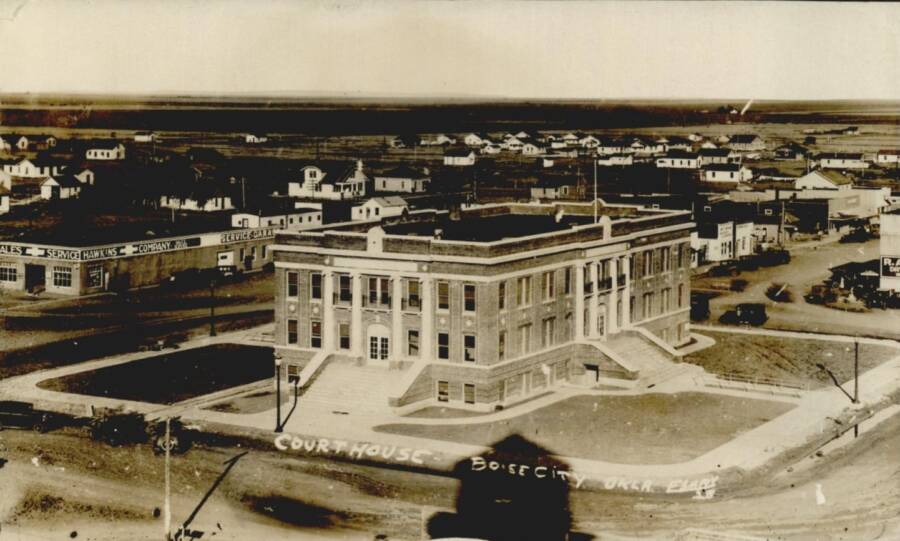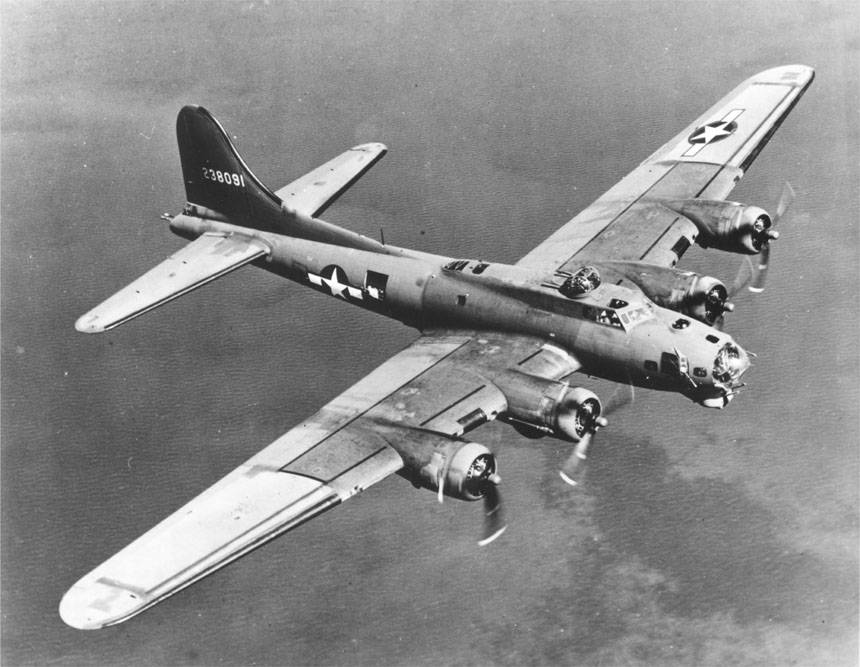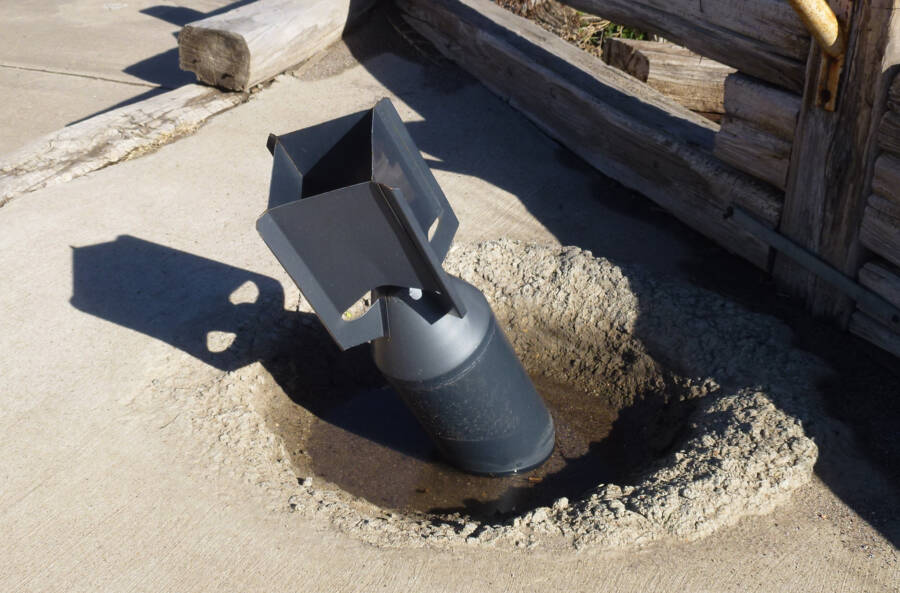The Boise City bombing took place on July 5, 1943, when a U.S. Army Air Corps flight crew got lost and mistakenly dropped practice bombs on Boise City, Oklahoma.

Oklahoma Historical SocietyA flight crew mistook the lights from the courthouse in Boise City, Oklahoma, seen here, as the lights from their practice field during the Boise City bombing.
Small Town, USA is the most accurate description of Boise City, Oklahoma. Sitting on a remote western edge of the Oklahoma panhandle, the population of this rural town has been between 1,000 and 2,000 since 1943, and the majority of its residents are ranchers and farmers. Yet, this sleepy town is best known for a dramatic World War II incident known as the Boise City bombing.
At half past midnight on July 5, 1943, the inhabitants of Boise City suddenly awoke to a sequence of explosions that sounded eerily similar to the fireworks they had set off the day before for the Fourth of July. The citizens of Boise City had no idea their town was actually being bombed — by a flight crew with the U.S. Army Air Corps.
This is the story of the Boise City bombing, one of the strangest moments of World War II.
The Accidental Aerial Bombing Of An American City During World War II

Wikimedia CommonsAerial shot of a B-17 Flying Fortress bomber leveling off during a target run.
The United States joined World War II after the 1941 bombing of Pearl Harbor and, by 1943, was firmly embroiled in the conflict. The war permeated all parts of American life. Patriotic fervor had risen to a fever pitch, and Americans everywhere were subject to food rationing. Meanwhile, young soldiers were training at army bases across the country to prepare to fight in the European or Pacific Theater.
Early on July 5, 1943, that’s what a U.S. Army Air Corps flight crew in Texas set out to do. That morning, while it was still dark, pilots at the Dalhart Army Air Base in Texas prepared four B-17 bombers for a practice mission. They flew toward a practice bombing range in nearby Conlen, but one of the planes accidentally veered 43 miles off course.
Their aerial target was a small area, lit by four lights in each corner. But the crew of this plane made a mistake. Far off course, they identified the lights of Cimarron County Courthouse in Boise City as their target.

Oklahoma Historical SocietyThe flight crew that accidentally dropped six practice bombs on Boise City, Oklahoma, in July 1943.
As the townspeople slept peacefully below, the plane prepared to drop its practice bombs. The Boise City bombing had begun.
How The Boise City Bombing Unfolded
At 12:30 a.m., the Boise City bombing began. The flight crew dropped six practice bombs on the town below which, fortunately, were composed of 96 pounds of sand and three pounds of dynamite. This meant that they were far less lethal than regular bombs, but also perfectly capable of causing damage.
As the terrified residents awoke to the sound of explosions, the bombs hit a garage, a church, and city streets, and nearly missed a fuel truck.
“There were five of us girls with soldiers from Dalhart,” one witness to the Boise City bombing recalled to Time magazine two weeks later. “A bomb dropped. I asked a soldier what it was and he said, ‘By God, it’s bombs!’ We ran just as fast as we could.”
In total, the “air raid” lasted for 30 terrifying minutes.

Oklahoma Historical SocietyA front page story about the Boise City bombing on July 8, 1943.
As many people sought cover, the town’s air warden, John Adkins, phoned the FBI and reported the attack, stating, “Boise City bombed [1:00 AM] Baptist church, garage hit.”
Radio operators soon contacted all nearby military aircraft to alert them that someone was bombing Boise City though, in the air, the guilty B-17 crew didn’t realize what they had done. It wasn’t until a city power plant worker flipped the main switch and plunged the city into darkness that the aircraft crew realized their mistake.
As the flight crew returned to the Dalhart base to face the repercussions, residents of Boise City waited for the sun to rise to see how the Boise City bombing had impacted their town.
The Aftermath Of The Boise City Bombing Raid

Cimarron Heritage CenterTwo women stand in a crater left by the Boise City bombing.
Despite the barrage of bombs, the actual property damage to Boise City amounted to less than $25, and, somehow, not a single person was injured during this unforeseen “attack.” Still, the residents of Boise City reacted with shock and outrage over the incident.
“I thought I had about reached the saturation point in horrible, mortifying experiences,” Fred R. Kreiger, a writer for the Boise City News wrote, according to the Saturday Evening Post. “But last Monday night marked an epoch in my experiences of dread and anxiety, when several airships appeared over Boise City.”
They weren’t the only ones upset about the Boise City bombing. The flight crew was in deep trouble over the incident, and War History Online reports that the crew was given a choice to either go straight to the front or be court martialed. They chose the former, and went on to bravely lead an 800-plane daytime raid on Berlin in 1944. War History Online also reports that the navigator, John M. Daly, was dismissed, though it’s reported elsewhere that he served bravely in World War II and earned the Distinguished Flying Cross.

Granger Meador / Flickr A memorial for the bombing raid in the downtown square.
A few weeks after the bombing, a railroad worker would discover the remains of an unclaimed and undetonated bomb from the raid and store it in his barn until his death in 2019. It would later go on display outside the Cimarron Heritage Center, the town’s museum.
Indeed, while residents of Boise City initially responded to the Boise City bombing with fear and anger, the decades have since soothed any lingering animosity. Today, the town approaches the incident with a sense of humor and joy.
On the 50th anniversary of the event, they even invited the crew of the B-17 back to Boise City (though none of them showed up, possibly due to lingering embarrassment). Boise City also dedicated a bronze plaque and a replica of one of the bombs to remember the historic military blunder.
On the 80th anniversary of the Boise City bombing in 2023, Ellis Marie Adee Ward, a 99-year-old resident who lived through the event, recalled her experience.
“I just remember being asleep at night and hearing something exploding. Well, sure enough, when we went downtown, we found out we’d been bombed,” she stated. “I wasn’t afraid, because I really didn’t know what was happening. I just thought it was something a long ways off.”
After reading about the Boise City bombing, go inside the harrowing story of the Blitz, the Nazi bombing raid on London. Or, discover the fascinating forgotten story of the Night Witches, the all-female Soviet air force regiment that flew 800 missions on the Eastern Front.





